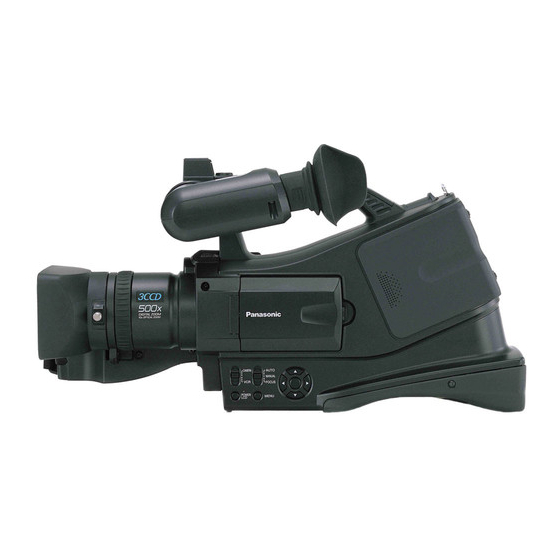Panasonic AGDVC20P - 3 CCD DV CAMCORDER Betriebsanleitung - Seite 38
Blättern Sie online oder laden Sie pdf Betriebsanleitung für Camcorder Panasonic AGDVC20P - 3 CCD DV CAMCORDER herunter. Panasonic AGDVC20P - 3 CCD DV CAMCORDER 42 Seiten. Agmini-dv camera/recorder
Auch für Panasonic AGDVC20P - 3 CCD DV CAMCORDER: Betriebsanleitung (40 seiten), Betriebsanleitung (42 seiten)

Do not throw old battery into fire.
≥Heating a battery or throwing it into a fire may result in an
explosion.
≥If the operating time is very short even after the battery has
been recharged, the battery has worn out. Please purchase a
new battery.
ª
About the AC adapter
≥If the battery is warm, charging requires more time than
normal.
≥If the temperature of the battery is extremely high or
extremely low, the [CHARGE] lamp may continue flashing,
and the battery may not be charged. After the battery
temperature has decreased or increased sufficiently,
recharging starts automatically. So, wait for a while. If the
lamp still continues flashing even after the recharging, the
battery or AC adapter may be faulty. If so, please contact a
dealer.
≥If you use the AC adapter near a radio, radio reception may
be disturbed. Keep the AC adapter 1 m (3 feet) or more away
from radio.
≥When using the AC adapter, it may generate whirring sounds.
However, this is normal.
≥After use, be sure to pull out the AC mains lead from the AC
mains socket. (If they are left connected, a minute amount of
current is consumed.)
≥Always keep the electrodes of the AC adapter and battery
clean.
ª
About the cassette
Never place the cassette in a high temperature place.
≥The tape may be damaged, producing mosaic-like noise at
the time of playback.
When storing the cassette after use, be sure to rewind the
tape to the beginning and take it out.
≥If the cassette is left for more than 6 months (depending on
the storage condition) in the camera-recorder or stopped
midway, the tape may sag and be damaged.
≥Once every 6 months, wind the tape to the end and then
rewind it to the beginning. If the cassette is left for 1 year or
longer without winding or rewinding, the tape may be
deformed by expansion or shrinkage attributable to
temperature and humidity. The wound tape may stick to itself.
≥Dust, direct sunlight (ultraviolet rays), and humidity may
damage the tape. Such usage may cause damage to the
camera-recorder and the heads.
≥After use, be sure to rewind the tape to the beginning, put the
cassette in the case to protect it from dust, and store it
upright.
Keep the cassette away from strong magnetism.
≥Apparatuses using magnets such as magnetic necklaces and
toys have magnetic force that is stronger than expected, and
they may erase the contents of a recording or may increase
noise.
38
Others
ª
LCD monitor/viewfinder
LCD monitor
≥When the LCD monitor gets dirty, wipe it with a dry soft cloth.
≥In a place with drastic temperature changes, condensation
may form on the LCD monitor. Wipe it with soft dry cloth.
≥If your camera-recorder is extremely cold, the LCD monitor is
slightly darker than usual immediately after you turn the
power on. However, as the internal temperature increases, it
goes back to normal brightness.
Extremely high precision technology is employed to
produce the LCD monitor screen featuring a total of
approximately 113,000 pixels. The result is more than
99.99% effective pixels with a mere 0.01% of the pixels
inactive or always lit. However, this is not a malfunction
and does not affect the recorded picture.
Viewfinder
≥To remove dust from inside the viewfinder, dismount the
viewfinder first. When the dust is difficult to remove, get rid of
it with a cotton swab dampened with water. Then wipe the
viewfinder with a dry cotton swab.
≥To clean the inside of the Viewfinder, remove the Eyecup 1,
then keep pressing 2 and pull the cover 3 out.
3
2
Extremely high precision technology is employed to
produce the viewfinder screen featuring a total of
approximately 113,000 pixels. The result is more than
99.99% effective pixels with a mere 0.01% of the pixels
inactive or always lit. However, this is not a malfunction
and does not affect the recorded picture.
The range of view shown in the LCD or viewfinder is
slightly narrower than that outputted from the video
output socket.
ª
Periodical check-ups
≥To maintain the highest image quality, we recommend
replacing worn parts such as heads after approx. 1000 hours
of use. (This, however, depends on operating conditions
including temperature, humidity and dust.)
1
